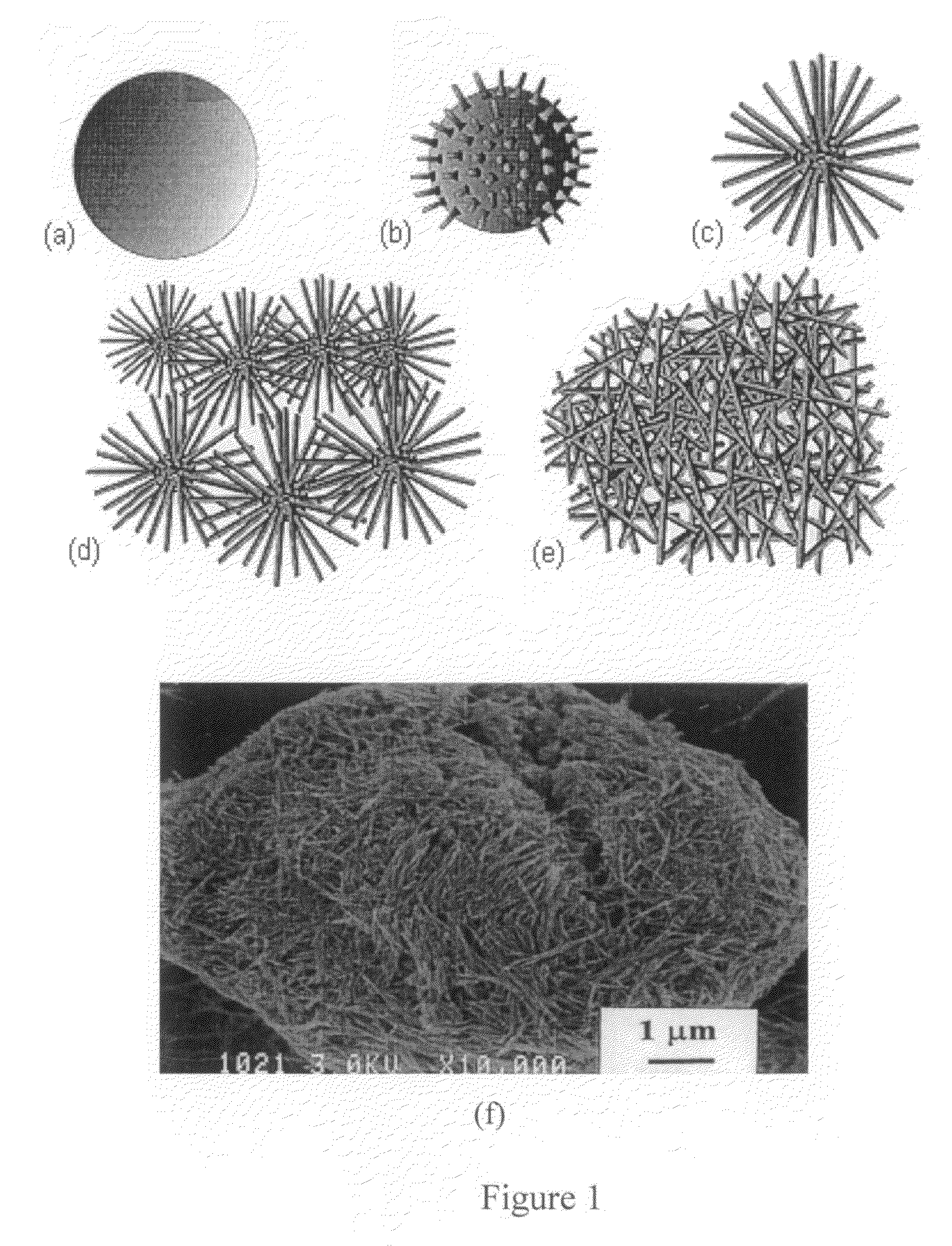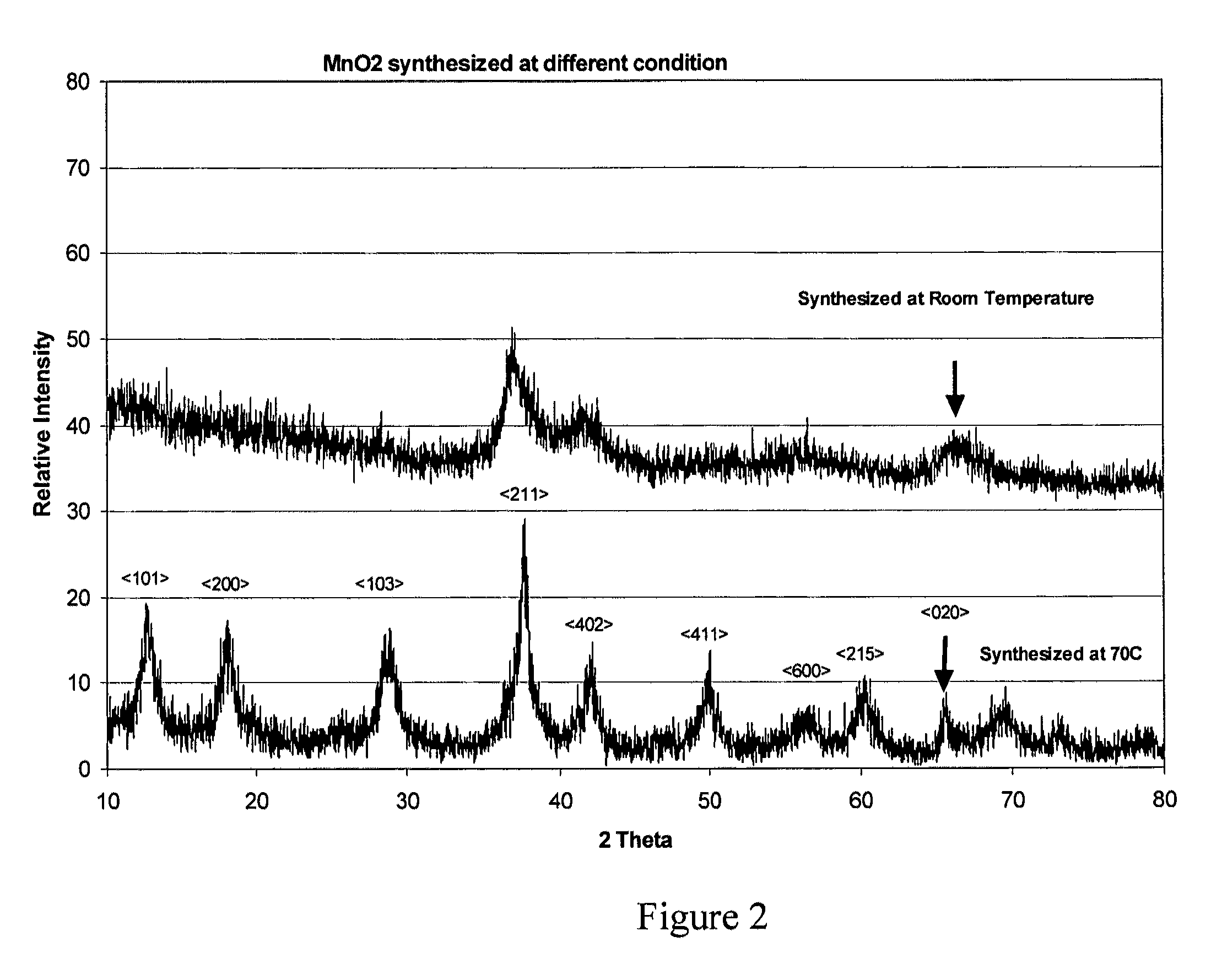Nanostructured Compositions Having Reduced Dissolution of manganese and methods of making and using the same
- Summary
- Abstract
- Description
- Claims
- Application Information
AI Technical Summary
Benefits of technology
Problems solved by technology
Method used
Image
Examples
example 1
Manganese Dioxide Nanofiber Synthesis and Characterization
[0068]MnO2 was synthesized by oxidizing manganese sulfate (MnSO4) with potassium permanganate (KMnO4) under acidic conditions according to reaction (1).
2KMnO4+3MnSO4+2H2O→5MnO2↓+K2SO4+2H2SO4 (1)
[0069]The reaction time and temperature were adjusted to control the crystallinity, morphology, and catalytic activity of the material. A schematic illustration showing the gradual transformation of MnO2 nanoparticle agglomerates into a mass of interconnected nanofibers is shown in FIG. 1. These transformations can be controlled by adjusting time and / or temperature of the reaction. It is believed that the MnO2 is more active in the nucleation and growth stages than during the other stages.
[0070]Powder X-ray diffraction (XRD) patterns of the MnO2 were obtained on a Broker D5005 or D8 diffractometer equipped with a 2.2 kilowatt (kW) copper X-ray tube. The equipment was run at 40 kilovolts (kv) and 20 milliAmpere (mA) by step-scanning wi...
example 2
Evaluation of MnO2 for Water Treatment
[0081]In this example, the MnO2 nanofibers synthesized according to Example 1 were evaluated for their efficiencies in oxidizing As(III) to As(V) in comparison with a commercially available product. The comparisons were made using rapid small scale column tests (RSSCTs) under a variety of experimental conditions. Using adsorption isotherm tests, MnO2 nanofibers were also evaluated for their performance in removing As(V) and Pb(II) from drinking water.
[0082]For all evaluation experiments, a so-called “challenge water” of the composition described in Table 2 was used. It has the same anionic composition as the National Sanitation Foundation (NSF) International Standard 53 Challenge Water used for evaluation of point-of-use devices for arsenic removal. Its calcium and magnesium concentrations were lowered to give the water greater long-term stability, as the NSF water is stable only for about 24 to about 48 hours, whereas the isotherm tests describ...
example 3
Iron Oxide Synthesis and Characterization
[0105]Fe2O3 was synthesized by preheating 100 mL water in a beaker to about 90° C. A 6M NaOH solution and 100 mL of a 2M Fe(NO3)3 solution were co-precipitated into the hot water while it was continuously heated and stirred. The pH of the precipitate was controlled at about 7.5. The precipitate was continuously refluxed at about 90° C. for 6 hours. The precipitate was then filtered, washed with water, and dried in an oven at about 100° C. The dried material was ground into a powder for further testing.
[0106]The SSA and pore analysis of this material was conducted using the BET method as described in Example 1. The SSA of this material was about 154 m2 / g, and the total pore volume was about 0.21 cm3 / g. XRD analysis revealed that this material possessed the α-Fe2O3 structure. The PZC of this material was at a pH of about 8.4. FIG. 11 is a SEM image, which shows agglomerates of about 100 to about 1000 nm, comprising Fe2O3 particles having an ave...
PUM
| Property | Measurement | Unit |
|---|---|---|
| Diameter | aaaaa | aaaaa |
| Diameter | aaaaa | aaaaa |
| Diameter | aaaaa | aaaaa |
Abstract
Description
Claims
Application Information
 Login to view more
Login to view more - R&D Engineer
- R&D Manager
- IP Professional
- Industry Leading Data Capabilities
- Powerful AI technology
- Patent DNA Extraction
Browse by: Latest US Patents, China's latest patents, Technical Efficacy Thesaurus, Application Domain, Technology Topic.
© 2024 PatSnap. All rights reserved.Legal|Privacy policy|Modern Slavery Act Transparency Statement|Sitemap



